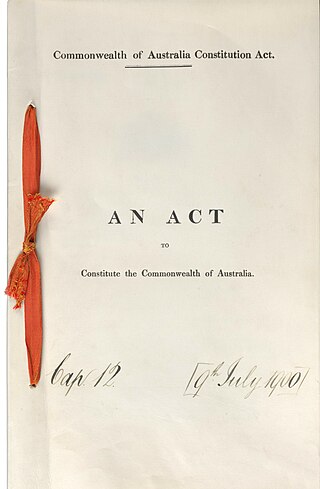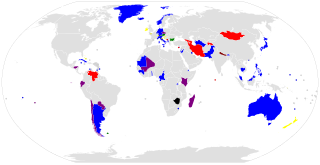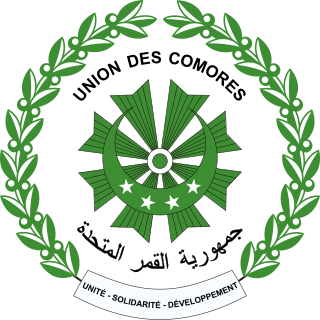
Norfolk Island is an external territory of Australia located in the Pacific Ocean between New Zealand and New Caledonia, approximately 1,412 km east of Australia's Evans Head and about 900 km from Lord Howe Island. Together with the neighbouring Phillip Island and Nepean Island, the three islands collectively form the Territory of Norfolk Island. At the 2021 census, it had 2,188 inhabitants living on a total land area of about 35 km2 (14 sq mi). Its capital and administrative seat is Kingston, while its main town and largest settlement is Burnt Pine.

Politics of Norfolk Island takes place in a framework of a parliamentary representative democratic entity. Norfolk Island is the only non-mainland Australian territory to have achieved self-governance. The Norfolk Island Act 1979, passed by the Parliament of Australia in 1979, is the Act under which the island is governed.
Republicanism in Australia is a movement to change Australia's system of government from a constitutional monarchy to a republic; presumably, a form of parliamentary republic that would replace the monarch of Australia with a non-royal Australian head of state. It is opposed to monarchism in Australia. Republicanism was first espoused in Australia before Federation in 1901. After a period of decline following Federation, the movement again became prominent at the end of the 20th century after successive legal and socio-cultural changes loosened Australia's ties with the United Kingdom.
A dependent territory, dependent area, or dependency is a territory that does not possess full political independence or sovereignty as a sovereign state and remains politically outside the controlling state's integral area. As such, a dependent territory includes a range of non-integrated not fully to non-independent territory types, from associated states to non-self-governing territories.
Constitutional conventions in Australia are significant meetings that have debated the Australian Constitution. The first two gatherings debated Federation and what form of Constitution to adopt, while the following conventions debated amendments to the document.

The flag of Norfolk Island is a triband consisting of green, white, and green bands charged with a green Norfolk Island pine in the centre. Adopted in 1979 when the islands gained limited self-government, it has been the flag of the Territory of Norfolk Island since 6 June of that year. The pine is native to the territory and is its official tree.

The second question of the 1967 Australian referendum of 27 May 1967, called by the Holt government, related to Indigenous Australians. Voters were asked whether to give the Commonwealth Parliament the power to make special laws for Indigenous Australians, and whether Indigenous Australians should be included in official population counts for constitutional purposes. The term "the Aboriginal Race" was used in the question.
In Australia, referendums are public votes held on important issues where the electorate may approve or reject a certain proposal. In contemporary usage, polls conducted on non-constitutional issues are known as plebiscites, with the term referendum being reserved solely for votes on constitutional changes, which is legally required to make a change to the Constitution of Australia.

The Australian republic referendum held on 6 November 1999 was a two-question referendum to amend the Constitution of Australia. The first question asked whether Australia should become a republic, under a bi-partisan appointment model where the president would be appointed by the federal parliament with a two-thirds majority. This was the model that was endorsed by the Constitutional Convention, held in Canberra in February 1998. The second question, generally deemed to be far less important politically, asked whether Australia should alter the Constitution to insert a preamble.

Australia uses three main time zones: Australian Eastern Standard Time, Australian Central Standard Time and Australian Western Standard Time.

The states and territories are the second level of government of Australia. The states are partially sovereign, administrative divisions that are self-governing polities, having ceded some sovereign rights to the federal government. They have their own constitutions, legislatures, executive governments, judiciaries and law enforcement agencies that administer and deliver public policies and programs. Territories can be autonomous and administer local policies and programs much like the states in practice, but are still legally subordinate to the federal government.
This electoral calendar 2009 lists the national/federal direct elections held in 2009 in the de jure and de facto sovereign states and their dependent territories. Referendums are included, although they are not elections. By-elections are not included.
A federacy is a form of government where one or several substate units enjoy considerably more independence than the majority of the substate units. To some extent, such an arrangement can be considered to be similar to asymmetric federalism.

The Constitution of Australia is the fundamental law that governs the political structure of Australia. It is a written constitution, which establishes the country as a federation under a constitutional monarchy governed with a parliamentary system. Its eight chapters set down the structure and powers of the three constituent parts of the federal level of government: the Parliament, the Executive Government and the Judicature.
There are six monarchies in Oceania with an individual hereditary monarch, who is recognised as the head of state. Each is a constitutional monarchy: the sovereign inherits his or her office, usually keeps it until death or abdication, but is bound by laws and customs in the exercise of their powers. Five of these independent states share King Charles III as their head of state, making them part of a global grouping known as the Commonwealth realms; in addition, all monarchies of Oceania are members of the Commonwealth of Nations. The only sovereign monarchy in Oceania that does not share a monarch with another state is Tonga. Australia and New Zealand have dependencies within the region and outside it, although five non-sovereign constituent monarchs are recognized by New Zealand, Papua New Guinea and France.

This national electoral calendar for 2013 lists the national/federal elections held in 2013 in all sovereign states and their dependent territories. By-elections are excluded, though national referendums are included.

The Constitution of the Comoros was adopted on 23 December 2001 and last amended in May 2009.
Constitutional recognition of Indigenous Australians refers to various proposals for changes to the Australian Constitution to recognise Indigenous Australians in the document. Various proposals have been suggested to symbolically recognise the special place Indigenous Australians have as the first peoples of Australia, along with substantial changes, such as prohibitions on racial discrimination, the protection of languages and the addition of new institutions. In 2017, the Uluru Statement from the Heart was released by Indigenous leaders, which called for the establishment of an Indigenous Voice to Parliament as their preferred form of recognition. When submitted to a national referendum in 2023 by the Albanese government, the proposal was heavily defeated.
An electoral status referendum was held in Norfolk Island on 21 October 1991 on whether Norfolk Island would become part of Canberra for electoral purposes.








